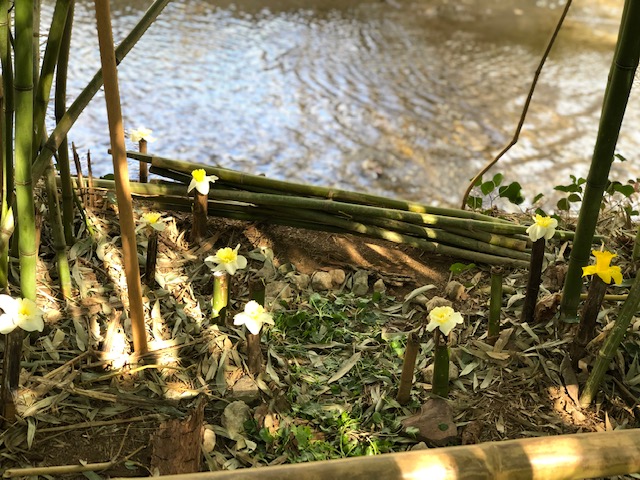
The path I take in the mornings has a stream, Stony Run, running along one side. The path and the stream are in a tiny wooded floodplain you could throw a rock across. The floodplain and stream are more or less maintained by Baltimore city and by the surrounding community associations – “maintained” as in, a massive re-engineering of the stream and massive clean-ups by the communities twice a year. But between massive efforts the floodplain is left to its own devices and being a floodplain, sometimes it floods. Mostly it just seeps. And after a rain, the path is a muddy patchy swamp. I can’t walk on it until it drains and I am sad.
After a rain a while back, I noticed path/mud remediation efforts that were not city or community, not massive, and in fact, were pretty pathetic. Somebody was trying to fill in the mud with solids, with brush, bricks, sticks, rocks, anything, but they all just sank. I don’t know who was doing this but the best bet was neighborhood kids; the little floodplain is an excellent place for kids to be kids in. You walk through that floodplain, looking at narrow paths leading into dense groves of bamboo, at piles of leaves, oddly-placed sticks, careful arrangements of this and that, and you feel that you’re intruding, that kids you can’t see are living here.
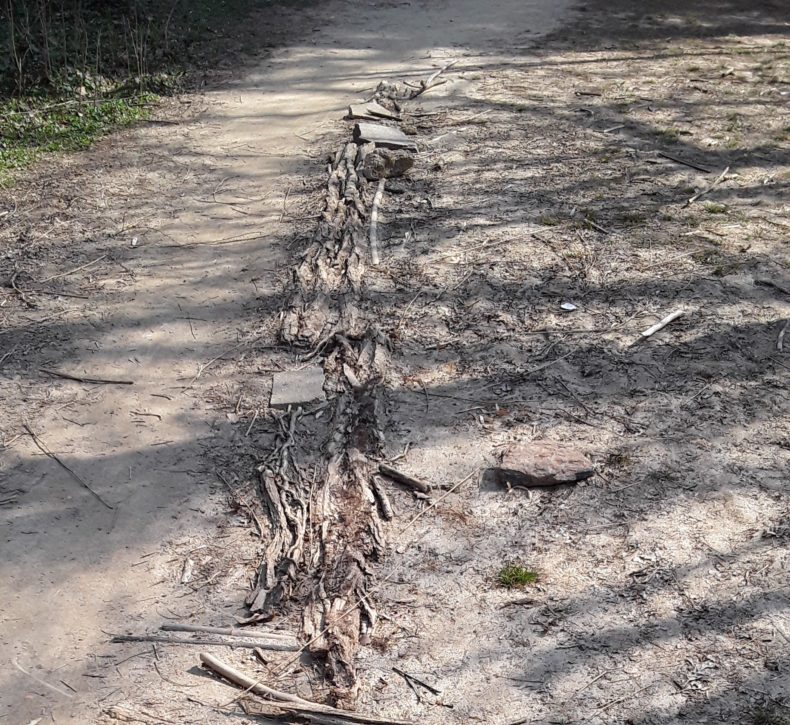
After the next couple of rains, I noticed that the remediation efforts had gotten more structured, as though someone were thinking this through. Bark stripped from dead trees was laid lengthwise over the muddy path, along with lengths of bamboo cut from a bamboo grove. This more orderly plan worked better. I wondered whether people faced with large muddy patches that interrupted paths had always done this sort of thing. And after I thought about it, I realized it reminded me of pictures I’d seen of prehistoric roadways. As always when reminded of something that would require research, I ignored it.
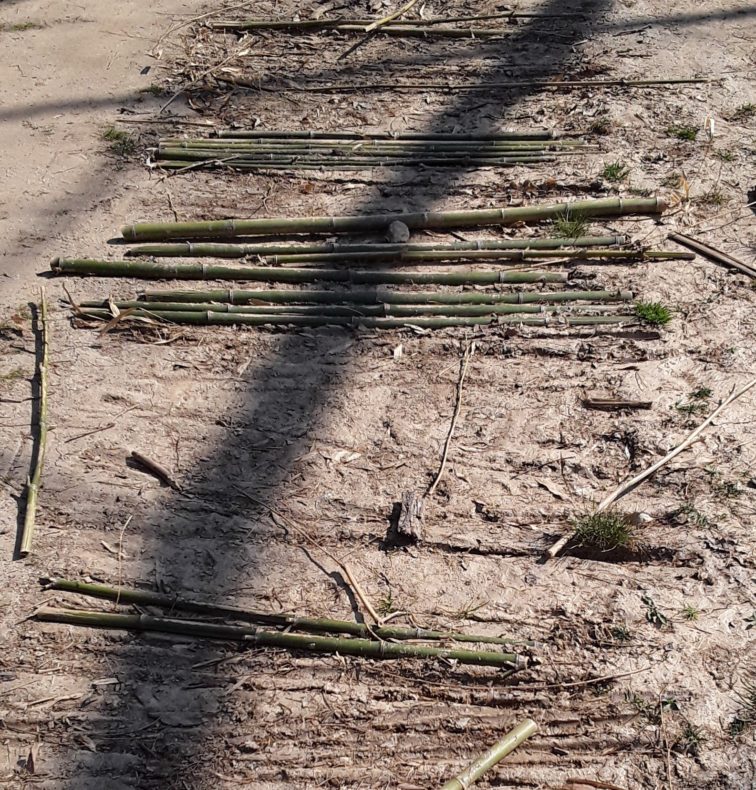
But then after the next rain, the path had more bamboo and this time, laid not lengthwise but across the path. This plan seemed to work better – the path was wider and the bamboo didn’t seem to sink into the mud as quickly. This was civilization evolving, the rise of the engineer and the next engineer after that, and now I needed to research it.
These path-plans are called trackways (a lot of other things are also called trackways) and they’re all over the world. The ones I liked best were the trackways on England’s Somerset Levels, a soggy peat moor that’s been inhabited since before the Neolithics. The Sweet Track was laid out like the path’s lengthwise bark and bamboo pattern. The Abbott’s Way is laid out like cross-wise bamboo pattern.
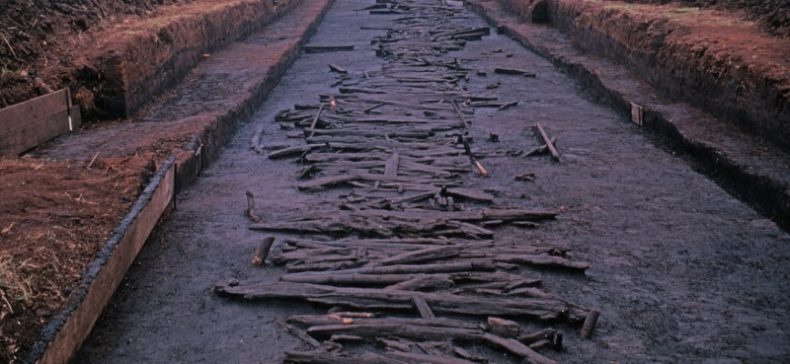
This is the Abbott’s Way track. I didn’t find out which pattern, lengthwise or cross-wise, was older because of previous policy about research and ignoring. So I can’t say one pattern evolved into the other, even though I strongly favor the cross-wise one as being more advanced – if for no other reason than it’s still being used and is called a corduroy road. The other reason I didn’t try dating the patterns is that I don’t trust dates because dating-methods are so different with such different margins of error. But these trackways are old, old, old, Neolithic, think of them as built by cavemen.
I’ve always liked the idea – which I think is not true – that as embryos develop, they recapitulate earlier stages of their species’ evolution. And this path seemed like that, neighborhood kids recapping the evolution of engineering.
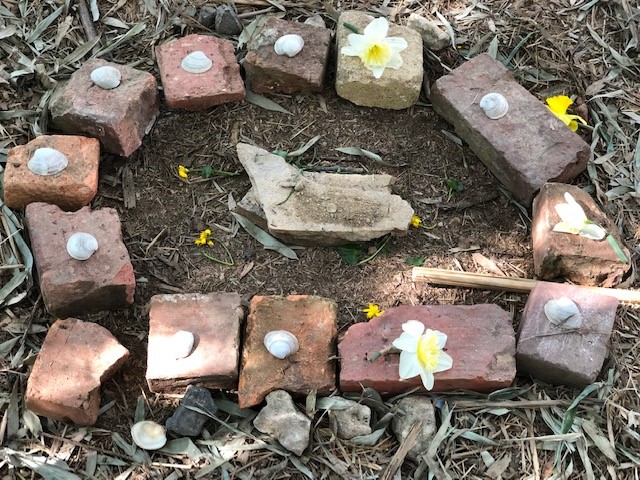
But that turns out not to be true either. One of the people living nearby was out in the floodplain the other day, inspecting the path, so I asked him who put it there. He said the engineering was sort of communal, but was mainly one neighbor who cut the bamboo. I hadn’t thought about that, kids not being able to cut 2-inch bamboo. So adults were recapping engineers evolving, not kids.
I’m not giving up entirely on the kids though. Evolution shows up not only in engineering but in art — cave art, stone carvings, even stone circles. One day I followed a narrow path into a bamboo grove, and in a clearing not quite big enough for me, was a careful circle of broken bricks, and on each, a shell from somebody’s collection or a flower from the floodplain. Adults don’t do these things, it’s the little Neolithic kids. Just because I don’t see them doesn’t mean they’re not there, evolving their little hearts out.
_______
Abbott’s Way photo from the Avalon Marshes Somerset website: which says that the photos are copyrighted by their owners but gives no links for the owners, so I do hope I’m not infringing but if so, I’ll take the photo right down.
All other photos courtesy of Dr. Elizabeth Selvin, friend and mother of a couple of those Neolithics.
I would expect that a cross-hatch would work best, one way, then the other, like weaving the road with mud and sticks. So maybe the first attempt wasn’t a first attempt, so much as a first layer?
Neil, if you do go to Somerset, could you report back? especially about the cross-hatching idea, which is brilliant. I’d be surprised if some Neolithic didn’t think of it. But as per my research policy, I haven’t any idea.
Cool though, I live reasonably near somerset, but didn’t know about the tracks… Probably worth a visit sometime, thanks.
“Adults don’t do these things, it’s the little Neolithic kids.”
My mom & I still do things like this. But we feel like kids when we do it so maybe that’s the point.
The link you gave to the abbots way shows they certainly did, I read it after making the comment. They had horizontal cross-beams with planks between them, like a railway track. But they also made V shapes into the mud with poles for supporting the planks too.. Pretty impressive for what you can make with sharp stones, but then all surviving ancient architecture and engineering is impressive, if nothing else but for surviving.